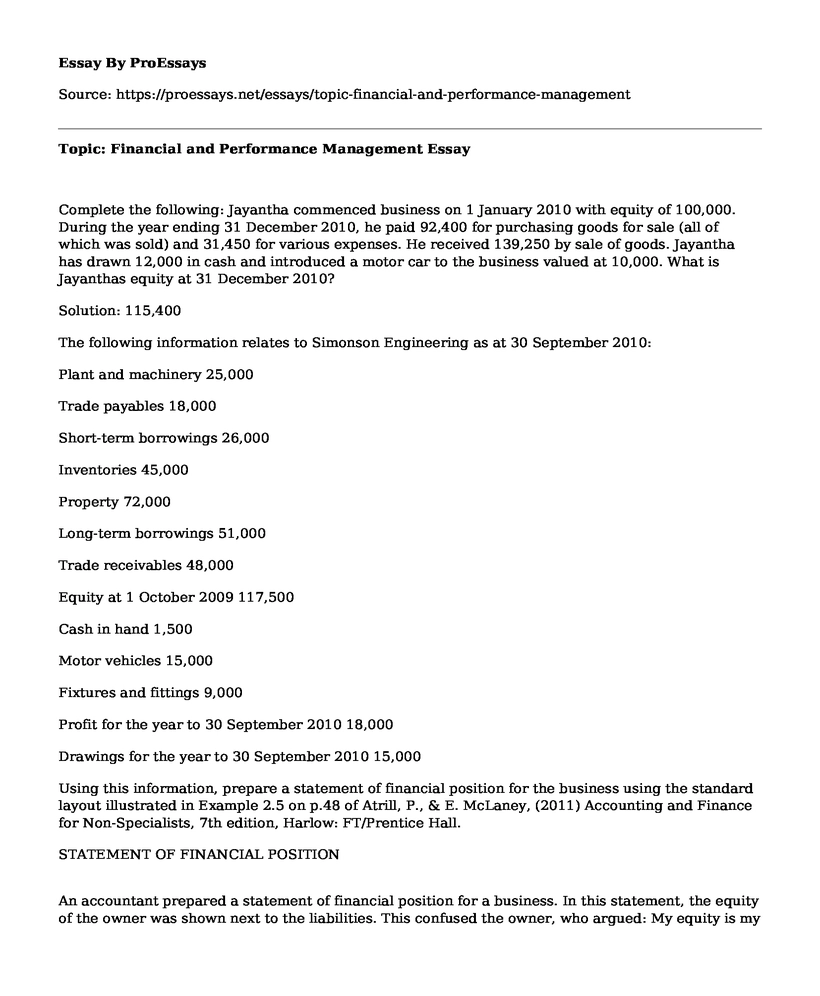Complete the following: Jayantha commenced business on 1 January 2010 with equity of 100,000. During the year ending 31 December 2010, he paid 92,400 for purchasing goods for sale (all of which was sold) and 31,450 for various expenses. He received 139,250 by sale of goods. Jayantha has drawn 12,000 in cash and introduced a motor car to the business valued at 10,000. What is Jayanthas equity at 31 December 2010?
Solution: 115,400
The following information relates to Simonson Engineering as at 30 September 2010:
Plant and machinery 25,000
Trade payables 18,000
Short-term borrowings 26,000
Inventories 45,000
Property 72,000
Long-term borrowings 51,000
Trade receivables 48,000
Equity at 1 October 2009 117,500
Cash in hand 1,500
Motor vehicles 15,000
Fixtures and fittings 9,000
Profit for the year to 30 September 2010 18,000
Drawings for the year to 30 September 2010 15,000
Using this information, prepare a statement of financial position for the business using the standard layout illustrated in Example 2.5 on p.48 of Atrill, P., & E. McLaney, (2011) Accounting and Finance for Non-Specialists, 7th edition, Harlow: FT/Prentice Hall.
STATEMENT OF FINANCIAL POSITION
An accountant prepared a statement of financial position for a business. In this statement, the equity of the owner was shown next to the liabilities. This confused the owner, who argued: My equity is my major asset and so should be shown as an asset on the statement of financial position. How would you explain this misunderstanding to the owner?
Assets are the not equity, liabilities are the outsiders or third partys claim into the business, and below it is equity, representing the owners claim into the enterprise.
The statement of financial position shows how much a business is worth. Do you agree with this statement? Explain the reasons for your response.
I agree, it shows the business worth as at the specified dates. Total assets represents the total business financial position.
Compute the missing amount in the accounting equation for each business. Name of business Assets Liabilities Equity
Hudson Gift and Cards 37,000 35,000
2000
New Street Garage 85,000 39,000
46000
Hair Styles 92,000 53,000
39000
At the year end, the total assets of a business were 189,000 and the total liabilities were 126,000. During the year, the owner withdrew 10,000 and introduced a further 18,000 in equity. The business began the year with total assets 180,000 and total liabilities of 112,000. What is the profit (loss) for the year? 8,000 (profit) 13,000 (loss) 8,000 (loss) 13,000 (profit)
A company that produces a single product provides the following information: budgeted sales of 40,000 units, margin of safety 25% of budgeted sales, total fixed costs 240,000. What is the contribution per unit of the companys product?
xbe=75% of 40000=30000 units=fixed costcomtribution margin=240000CM, CM=$8A business makes 2,000 units of a particular product. It spent 24,000 on material and it paid its operatives 40,000. Fixed costs of running the factory were 50,000. The salesforce were also paid 18,000 and the head office costs were 100,000. In order to break even the selling price per unit will have to be:
Variable cost per unit= 12+20= $32
2000sp-32=1680002000sp-64000=1680002000sp=232000sp=$116
Cite this page
Topic: Financial and Performance Management. (2021, Mar 12). Retrieved from https://proessays.net/essays/topic-financial-and-performance-management
If you are the original author of this essay and no longer wish to have it published on the ProEssays website, please click below to request its removal:
- TamTam Cereal Market Strategy Implementation Plan
- Security Organizations and Roles of a Security Manager Paper Example
- Nokia Company Organizational Change Paper Example
- Assessing Political Risk Essay Example
- Essay on Innovative Change: The Central Part of Organizational Culture
- Paper Example on Managing Money: Financial Management, Investments & Cash Flow Analysis
- Business Strategies for a Dynamic Market: Research Paper







